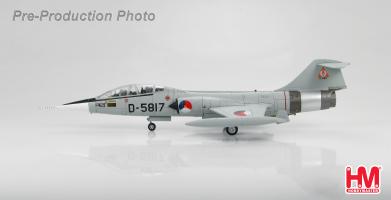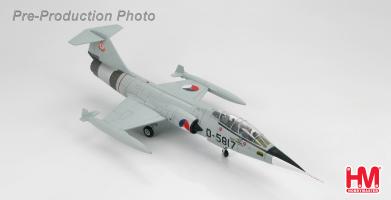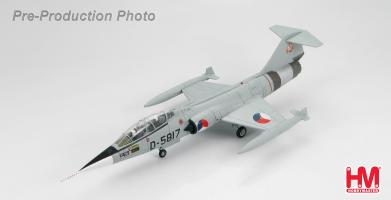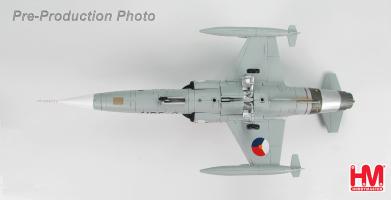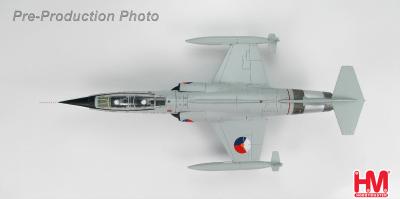Hobby Master Archive
Air Power Jets 1/72
F-104
Lockheed TF-104G D-5817, Training en Conversie Afdeling, late 1960s
Hobby Master 1/72 Air Power Series HA1055 Lockheed TF-104G D-5817, Training en Conversie Afdeling, late 1960s
The extreme shape of the Starfighter earned it the first nickname of “The Missile with a Man in it” and some USAF pilots also called it “Zipper” or “Zipper 104” because of it’s tremendous speed. After it proved to be challenging to fly, with high fatal accident rates, particularly in German service the plane was given many more nicknames because of its high speed and ability to occassionally fly itself into the ground. In Germany they referred to it as Witwenmacher (“widowmaker”), fliegender Sarg (“flying coffin”) or Erdnagel (“ground nail”, the official military term for a tent peg). Others were, Pakistan Badmash “Hooligan”, Italy because of it’s spiked nose Spillone “Hatpin” and bara volante “Flying Coffin”, Canada “Lawn Dart”. Primarily powered by a single 15 800 lb thrust General Electric J79-GE11A turbojet engine, equipped with afterburner, it was capable of high speeds (just under 1300 mph) and high rates of climb. On December 14, 1959, an F-104C set a world altitude record of 103,395 ft (31.5 km). The Starfighter was the first aircraft to hold simultaneous official world records for speed, altitude, and time-to-climb.
The Royal Netherlands Air Force (Koninklijke Nederlandse Luchtmacht) was a major operator of the Lockheed F-104G with 138 aircraft. Between 1962 and 1984 the KLu used 3 variants, F-104G, TF-104G and the RF-104G. The 138 aircraft consisted of 95 F- 104G/RF-104 built by Fokker, 25 F-104G built by FIAT and 18 TF-104G built by Lockheed in California. The TF-104Gs were used by an operational conversion unit known as the “Dutch Masters” and when this unit was decommissioned in January 1969 the aircraft went to “TCA”(Training en Conversie Afdeling) at Leeuwarden and “CAV” (Conversie Afdeling Volkel), Volkel . In March 1978 “TCA” unit was decommissioned and the remaining aircraft were assigned to the “CAV” at Volkel. When the F-104s were completely retired in 1984 the “CAV” was decommissioned in November of that year. TF- 104G D-5187 was c/n 583A-5817 and was delivered on January 2, 1968. D-5187 served with the KLu until it was sold to Turkey on November 30, 1983.
Specifications for the F-104G / TF-104G F-104G Role - all-weather multi-role fighter-bomber Production - 1,122 Crew - 1 TF-104G Role - combat-capable trainer version of F-104G Production - 220 Crew - 2 NORMAL PERFORMANCE Engine - 1 x General Electric J-79 of 15,600 lbs. thrust with afterburner Increased Internal Fuel Capacity Maximum speed - 1,320 mph Cruising Speed - 575 mph Combat Radius - 420 mi Ferry Range - 1,630 mi Service Ceiling - 58,000 ft Rate Of Climb - 48,000 ft/min Dimensions Span - 21 ft. 11 in Length - 54 ft. 10 in Height - 13 ft. 6 in Weight Empty - 14,000 lbs Loaded - 20,640 lbs Maximum Takeoff - 29,027 lbs Armament F-104G 1 x M-61 20mm M61 Vulcan 6-barrel cannon Hardpoints - 7 x capable of carrying a maximum 4,000 lbs of stores Located - 2 x wing-tip launch rails for AIM-9 Sidewinder or similar missiles 4 x 2 under each wing 1 x under-fuselage center-line pylon TF-104G No cannon or centerline pylon Reduced internal fuel
Die-cast metal. Superb detailing in 1/72 scale. Pilot figure Pad applied markings. Fully assembled. Display stand included. Option to display model with wheels up or down. Minimum use of plastic. Very collectable
| Added to archive | 2015-11-19 |
| Last modified | 2015-11-19 |
| Leaflet | 2012-02-01 February 2012 |

